How Much Does It Cost to Paint a Building?
The average cost to paint a building ranges from $3.90 to $7.80 per square foot. For a typical 10,000 square foot building, this translates to a total cost of $50,700 to $101,400. These estimates can vary significantly based on the factors discussed below. It’s important to consider that high-quality materials and professional services may have a higher upfront cost but can save money in the long run by reducing the frequency of repainting and maintenance.
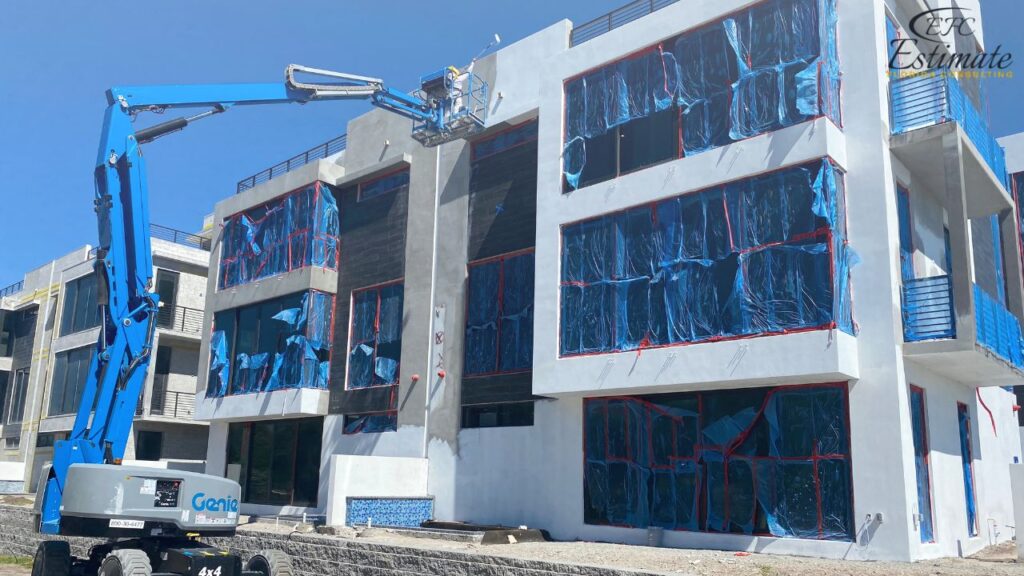
Factors Influencing the Cost
Size of the Building
The size of the building is one of the primary factors that determine the overall cost of painting. Larger buildings require more paint and labor, which increases the total cost. Additionally, taller buildings may require specialized equipment such as scaffolding or lifts, further adding to the expense. For example, a high-rise building with multiple stories will necessitate the use of cranes or scaffolding, leading to higher costs due to the need for additional safety measures and labor hours. Moreover, larger buildings may also have more intricate architectural features that require careful attention and more detailed work.
Type of Paint
The type of paint used can significantly impact the cost. High-quality paints with better durability and weather resistance are more expensive but offer long-term savings by reducing the frequency of repainting. Additionally, eco-friendly and low-VOC (volatile organic compounds) paints tend to cost more than standard paints. Using premium paints can ensure that the building’s exterior remains vibrant and protected for longer periods, minimizing maintenance costs over time. Different finishes, such as matte, satin, or gloss, can also affect the price and should be chosen based on the building’s requirements and desired appearance.
Surface Preparation
Proper surface preparation is crucial for a long-lasting paint job. This may include cleaning, sanding, patching, and priming the surfaces before applying the paint. The condition of the building’s exterior and the type of material (e.g., wood, stucco, metal) can affect the extent of preparation needed and, consequently, the cost. Neglecting adequate surface preparation can lead to premature paint failure, necessitating more frequent repaints and higher long-term costs. Ensuring thorough preparation helps achieve a smooth, even finish and enhances the paint’s adhesion and durability.
Labor Costs
Labor costs vary depending on the complexity of the job, the skill level of the painters, and regional wage rates. Skilled painters may charge higher rates, but their expertise can ensure a high-quality finish that lasts longer. In areas with a higher cost of living, labor costs will also be higher. Investing in experienced painters can result in a more professional finish and reduce the likelihood of costly mistakes or rework. Additionally, the efficiency and speed of experienced painters can help complete the project within a shorter timeframe, reducing overall labor costs.
Accessibility
The accessibility of the building can influence the cost. Buildings with difficult-to-reach areas, such as high-rise structures or those with intricate architectural features, may require special equipment and additional labor, increasing the overall expense. Accessibility challenges can also prolong the project duration, leading to higher labor costs. Proper planning and the use of appropriate equipment are essential to safely and effectively reach all areas of the building, ensuring a comprehensive paint job.
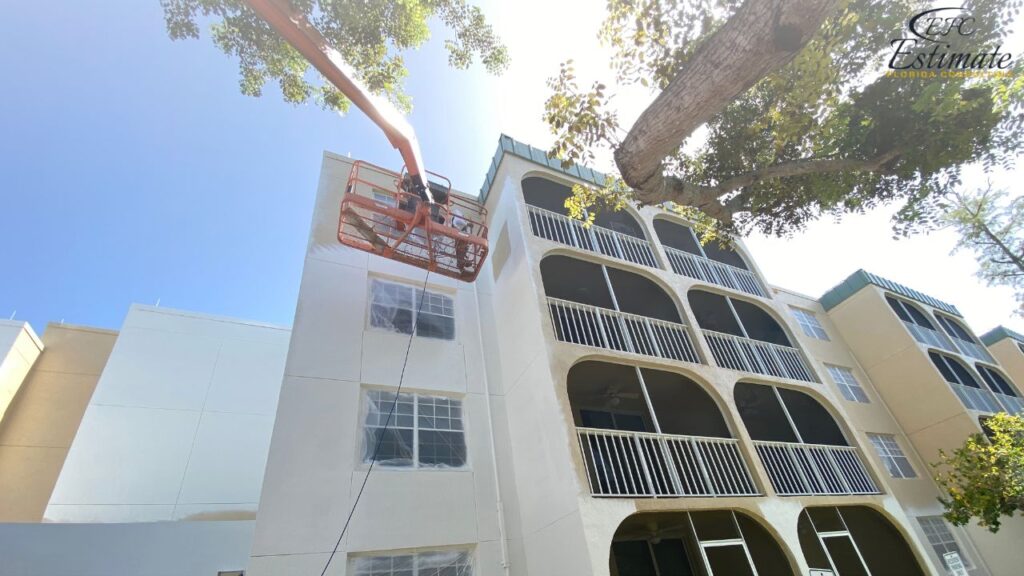
Cost Breakdown
Materials
The cost of materials includes the paint, primers, sealants, and any other supplies needed for the job. High-quality exterior paints can cost between $39 and $91 per gallon. The amount of paint required depends on the size of the building and the number of coats needed. Primers and sealants are additional costs that ensure better adhesion and durability. Using high-quality materials helps achieve a longer-lasting finish and reduces the need for frequent touch-ups or repaints.
Material Type | Estimated Cost per Gallon |
Standard Paint | $26 – $52 |
High-Quality Paint | $39 – $91 |
Primer | $26 – $39 |
Sealant | $26 – $52 |
Labor
Labor costs are typically charged by the hour or by the square foot. On average, professional painters charge between $2.60 and $5.20 per square foot, including labor and materials. For a 10,000 square foot building, labor costs alone can range from $26,000 to $52,000. Labor costs can vary significantly based on the complexity of the job and the experience of the painters. High-quality labor ensures a professional finish that enhances the building’s appearance and longevity.
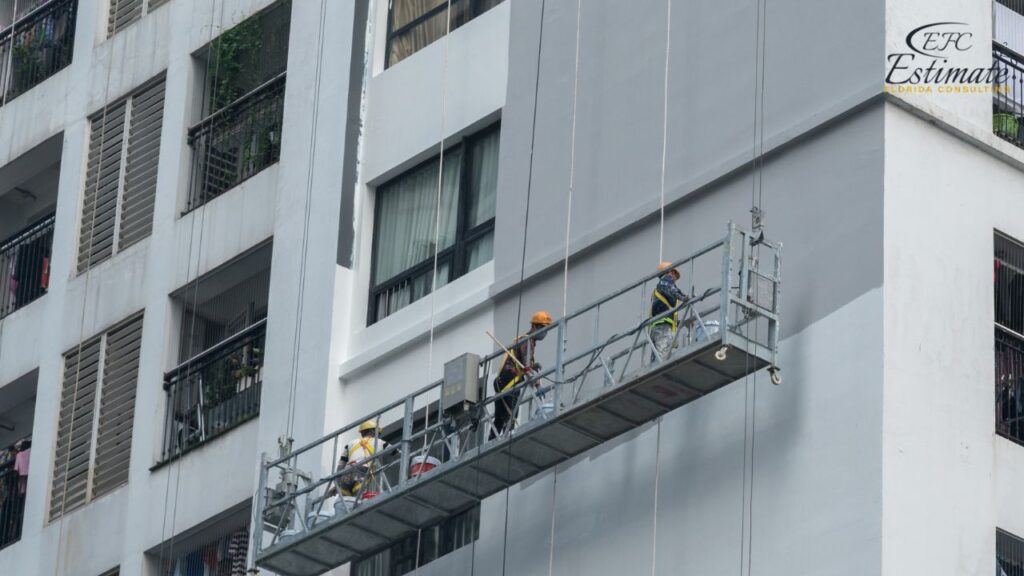
Labor Type | Estimated Cost per Sq Ft |
Standard Labor | $2.60 – $5.20 |
Specialized Labor | $5.20 – $7.80 |
Equipment and Safety
Specialized equipment such as scaffolding, lifts, and safety gear are often required for painting large or tall buildings. Renting or purchasing this equipment adds to the overall cost. Safety considerations are paramount, especially for high-rise buildings, and may require additional investments in safety measures and training. Ensuring the safety of workers is critical to prevent accidents and ensure compliance with regulations.
Equipment Type | Estimated Rental Cost |
Scaffolding | $130 – $650 per day |
Lifts | $260 – $1,040 per day |
Safety Gear | $65 – $195 per worker |
Additional Costs
Permits and Inspections
Depending on the location and the scope of the project, you may need permits and inspections, especially for commercial buildings or historic properties. These costs can vary widely based on local regulations. Securing permits ensures that the project complies with local building codes and standards, potentially avoiding costly fines or project delays. Proper documentation and adherence to regulations are essential for a smooth and legally compliant project.
Permit Type | Estimated Cost |
Standard Permit | $130 – $650 |
Historic Property Permit | $260 – $1,300 |
Repairs and Maintenance
If the building’s exterior requires repairs before painting, such as fixing cracks, replacing damaged siding, or repairing windows, these costs must be factored in. Proper maintenance and repairs are essential for ensuring the longevity of the paint job. Addressing underlying issues before painting can prevent future damage and additional expenses. Regular maintenance and timely repairs help preserve the building’s structural integrity and aesthetic appeal.
Repair Type | Estimated Cost |
Crack Repair | $130 – $650 |
Siding Replacement | $2.60 – $13 per sq ft |
Window Repair | $260 – $780 per window |
Download Template For Building Painting Project Breakdown
- Materials list updated to the zip code
- Fast delivery
- Data base of general contractors and sub-contractors
- Local estimators

Cost to Paint Different Types of Buildings
Commercial Buildings
Commercial buildings often have larger surface areas and more complex structures, leading to higher painting costs. The type of business and its specific needs can also impact the overall cost. For example, a retail store may require a more durable and aesthetically pleasing finish compared to a warehouse. Commercial buildings also often have branding and aesthetic requirements that can affect the type and cost of paint used. Additionally, the presence of signage, logos, and specific color schemes can increase the complexity and cost of the project.
Residential Buildings
Painting residential buildings, such as apartment complexes or multi-family homes, typically involves considerations for aesthetics and durability. The cost can vary based on the number of units, stories, and architectural details. Residential projects may also require coordination with tenants, affecting the project’s timeline and cost. The choice of colors and finishes in residential buildings often aims to enhance curb appeal and marketability. Ensuring minimal disruption to residents while maintaining high-quality standards is crucial in residential painting projects.
Enhancement and Improvement Costs
Eco-Friendly Paint Options
Using eco-friendly paints with low VOCs can increase the initial cost but provide long-term health and environmental benefits. These paints reduce indoor air pollution and are often more durable, requiring less frequent repainting. Choosing sustainable materials supports environmental conservation efforts and can enhance the building’s marketability. Additionally, eco-friendly paints can contribute to a healthier indoor environment for occupants.
Eco-Friendly Paint | Estimated Cost per Gallon |
Low-VOC Paint | $52 – $104 |
Zero-VOC Paint | $65 – $130 |
Decorative Finishes
Adding decorative finishes such as murals, textured coatings, or faux finishes can enhance the aesthetic appeal of the building but will add to the overall cost. These finishes require skilled artisans and additional materials. Decorative elements can make a building stand out and potentially increase its value and appeal. Incorporating unique design features can create a distinctive look and attract more tenants or customers.
Decorative Finish | Estimated Cost per Sq Ft |
Murals | $13 – $65 |
Textured Coatings | $6.50 – $19.50 |
Faux Finishes | $7.80 – $26 |
Seasonal Considerations
Optimal Painting Seasons
The time of year can impact painting costs and project timelines. Painting during optimal weather conditions, typically spring and fall, can ensure better adhesion and longevity of the paint. Extreme temperatures and humidity levels can affect the drying and curing process, potentially leading to additional costs if the project needs to be redone or extended or if delays occur. Planning the project during favorable weather conditions helps achieve the best results and reduces the risk of weather-related setbacks. Seasonal considerations can also impact labor availability, as peak seasons may lead to higher rates and longer timelines due to increased demand for painting services.
Weather Implications on Painting Projects
Rain and Humidity
Rain and high humidity can negatively affect the painting process. If moisture levels are too high, paint may not adhere properly, leading to peeling and blistering in the future. This can result in costly rework and repairs. It’s advisable to monitor the weather closely and schedule painting projects for dry days with moderate humidity levels to ensure optimal conditions. Moreover, rainy seasons may require additional planning for potential delays and scheduling conflicts.
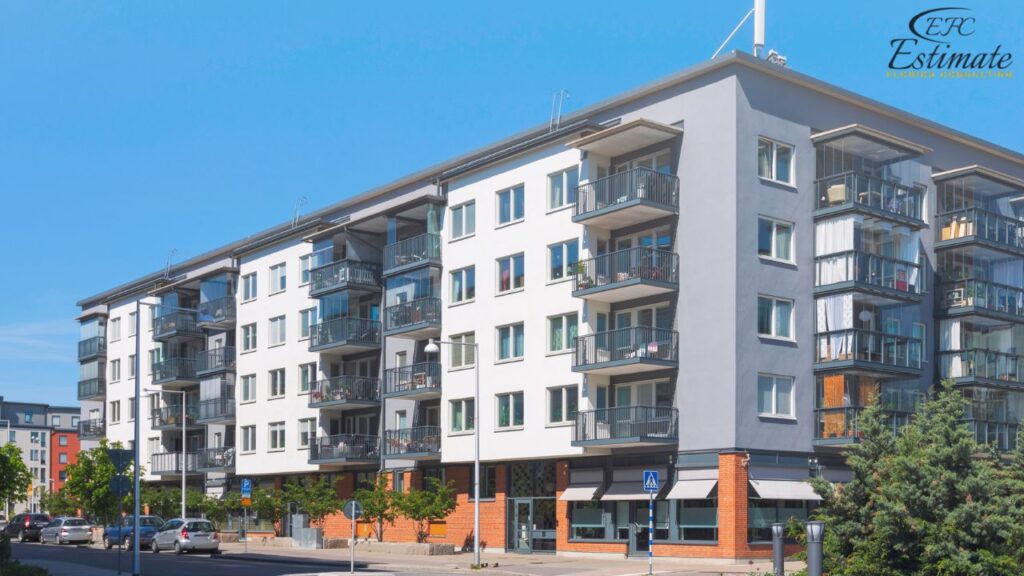
Temperature Considerations
Temperature plays a critical role in the painting process. Most paints have a specified temperature range for application, usually between 50°F and 85°F. Extreme cold can cause paint to freeze, while excessive heat can cause it to dry too quickly, leading to uneven application and poor adhesion. Thus, it is essential to consider the local climate and seasonal fluctuations when scheduling a painting project to ensure the best possible outcome.
Long-Term Maintenance Costs
Routine Inspections
Regular inspections of the painted surfaces can help identify potential issues early, such as fading, chipping, or cracking. Routine maintenance allows for touch-ups and minor repairs before they escalate into larger problems, potentially saving on repainting costs. Investing in regular inspections is crucial for preserving the appearance and longevity of the paint job. Establishing a routine maintenance schedule, such as semi-annual or annual check-ups, can help keep the building looking fresh and well-maintained.
Get 5 New Leads Next 7 Days With Our System
- Multi-Family House
- Single-Faimly House
- Modern House
- Duplex
- Ranch House
- Bungalow
Frequency of Repainting
The frequency of repainting depends on several factors, including the type of paint used, environmental conditions, and the quality of the initial application. On average, exterior paint may need to be reapplied every 5 to 10 years. However, high-quality paints and thorough maintenance can extend this period significantly. Understanding the expected lifespan of the chosen materials can help in budgeting for future repainting needs and overall building maintenance.
Conclusion
Painting a building is a significant investment that requires careful planning, budgeting, and consideration of various factors. Understanding the average costs, influencing factors, and long-term maintenance requirements can help ensure that you make informed decisions and achieve a successful outcome. Whether it’s a commercial or residential project, investing in quality materials and skilled labor can enhance the building’s aesthetic appeal and durability, ultimately leading to a better return on investment over time. By considering the entire scope of the project, from materials to labor to maintenance, you can develop a comprehensive plan that meets your specific needs and ensures the longevity of your painted surfaces.
FAQs
The average cost to paint a building ranges from $3.90 to $7.80 per square foot. For a typical 10,000 square foot building, the total cost can range from $50,700 to $101,400. These estimates can vary based on several factors, such as the size of the building, type of paint, and labor costs. Investing in high-quality materials and professional services can lead to long-term savings by reducing maintenance frequency.
Several factors can influence the cost of painting a building, including:
- Size of the Building: Larger buildings require more paint and labor, increasing total costs.
- Type of Paint: Higher quality and eco-friendly paints tend to cost more but can save money over time due to their durability.
- Surface Preparation: Proper preparation is crucial and may include cleaning, sanding, and priming, affecting overall costs.
- Labor Costs: Skilled painters may charge more, but their expertise can ensure a quality finish that lasts longer.
- Accessibility: Buildings that are hard to reach may require specialized equipment and additional labor.
The cost of materials includes paint, primers, sealants, and other necessary supplies. Here’s a general breakdown:
- Standard Paint: $26 – $52 per gallon
- High-Quality Paint: $39 – $91 per gallon
- Primer: $26 – $39 per gallon
- Sealant: $26 – $52 per gallon
Labor costs can range from $2.60 to $5.20 per square foot for standard labor. For specialized labor, costs may rise to $5.20 to $7.80 per square foot. For a 10,000 square foot building, labor costs alone can range from $26,000 to $52,000.
Specialized equipment may be required for larger or tall buildings, adding to the overall cost. Here are estimated rental costs for common equipment:
- Scaffolding: $130 – $650 per day
- Lifts: $260 – $1,040 per day
- Safety Gear: $65 – $195 per worker
- Commercial Buildings: Generally have larger surfaces and complex structures, leading to higher costs due to specialized requirements for durability and aesthetics.
- Residential Buildings: Costs can vary based on the number of units, stories, and coordination with tenants to minimize disruptions.
Eco-friendly paints with low VOCs can increase initial costs but offer long-term benefits, such as reducing indoor air pollution and requiring less frequent repainting. Typical costs for eco-friendly options are:
- Low-VOC Paint: $52 – $104 per gallon
- Zero-VOC Paint: $65 – $130 per gallon
Routine inspections can help identify potential issues early, preventing costly repainting. On average, exterior paint may need to be reapplied every 5 to 10 years, depending on the quality of materials and maintenance practices.
Google Reviews

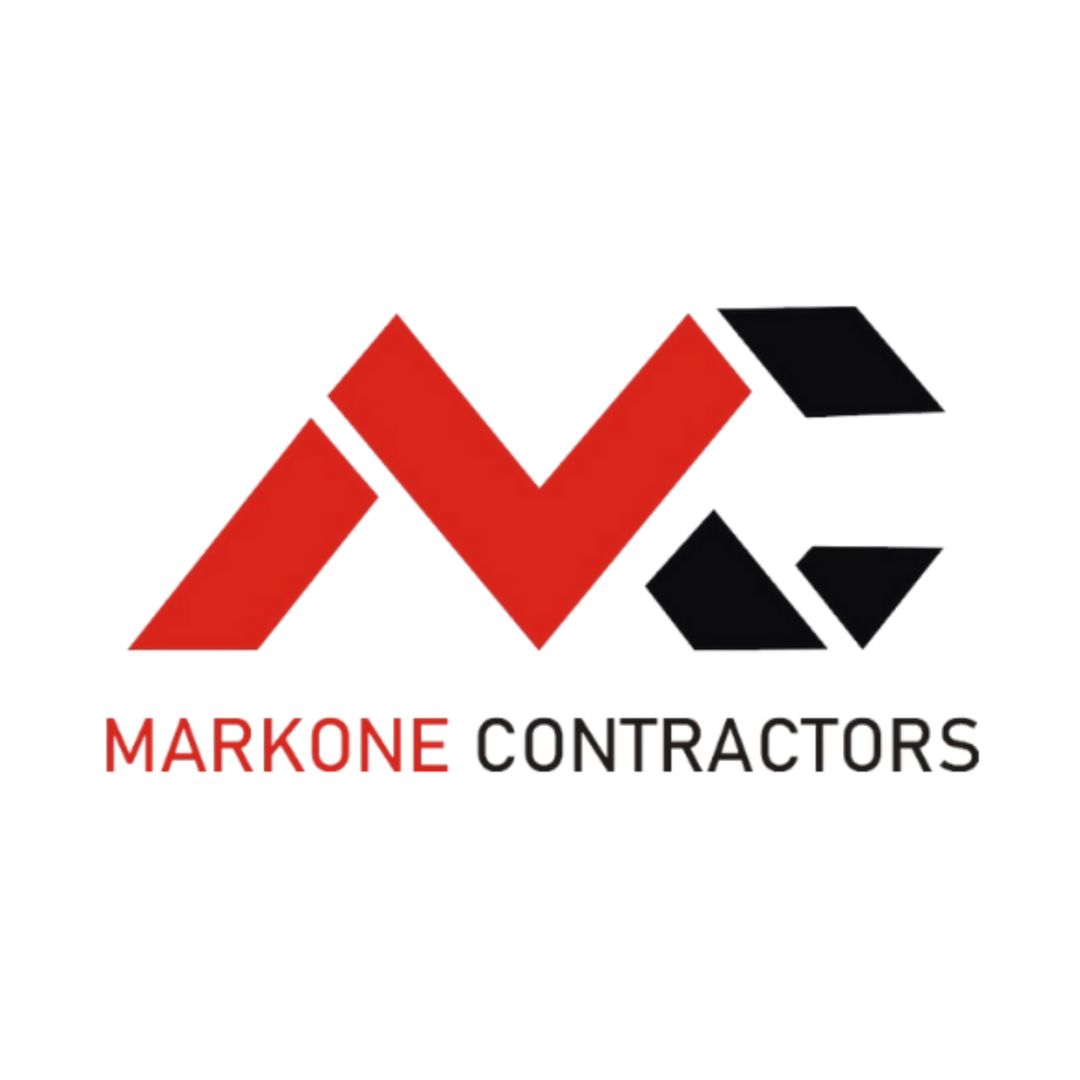

Process To Get Building Painting Cost Estimate Report
Here I am going to share some steps to get building painting cost estimate report.
-
You need to send your plan to us.
You can send us your plan on info@estimatorflorida.com
-
You receive a quote for your project.
Before starting your project, we send you a quote for your service. That quote will have detailed information about your project. Here you will get information about the size, difficulty, complexity and bid date when determining pricing.
-
Get Estimate Report
Our team will takeoff and estimate your project. When we deliver you’ll receive a PDF and an Excel file of your estimate. We can also offer construction lead generation services for the jobs you’d like to pursue further.

